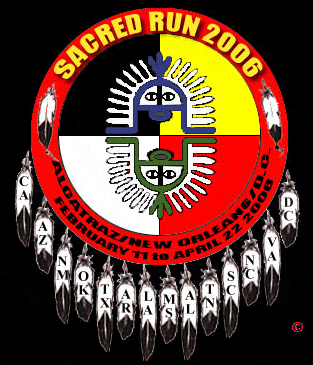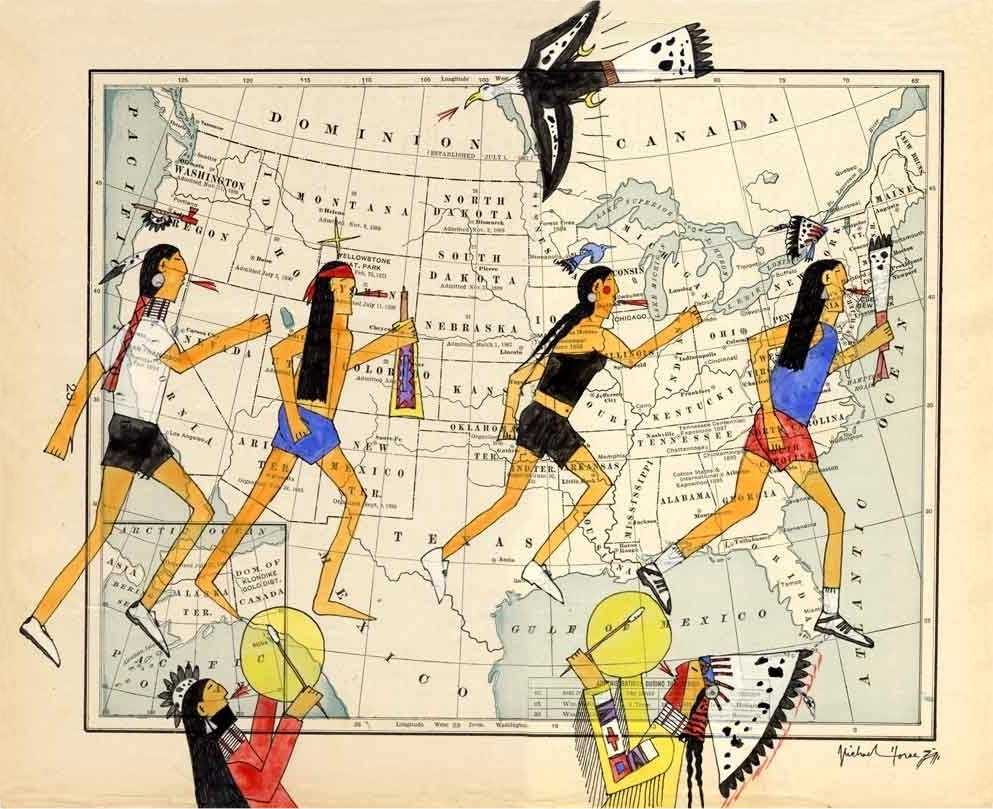Day
45 - Monday, March 27, 2006
Raceland,
Louisiana
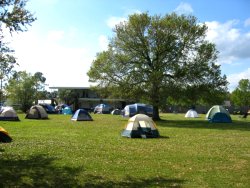 I've
been away from the Run for a few days, so I
have some catching up to do! Thankfully, others
are eager to tell the story and many have been
taking pictures. So here below is the first
of a series of articles covering the last few
days in Southern Louisiana.
I've
been away from the Run for a few days, so I
have some catching up to do! Thankfully, others
are eager to tell the story and many have been
taking pictures. So here below is the first
of a series of articles covering the last few
days in Southern Louisiana.
First, an overview: Hosted by the United Houma
Nation, our runners and walkers were treated
to a Benefit Concert on Saturday, March 25.
Joined by local runners and walkers, the group
ventured forth each Saturday, Sunday and Monday
from the campground in Raceland, Louisiana,
and ran through the bayous. I'm told it was
a great time, wonderful people!
Here
are some other pics from Bayou LaFourche & Southern
Louisiana...
Here is a piece by Jane Stillwater, posted
on her blog at http://jpstillwater.blogspot.com/
Born
on the bayou: Tribal Katrina victims, you
have not been forgotten!
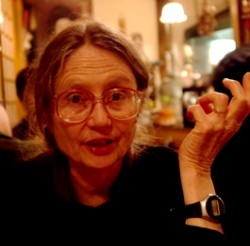 Holy
sheep dookie! I just got out of a Native American
sweat lodge. Those things are FIERCE! First
we all crowded into a willow frame covered
with really heavy felt blankets to hold in
the heat. Then some "Firemen" threw
a whole bunch of really hot rocks into the
tent and it got so hot that I thought my skin
was gonna turn into Kentucky fried chicken.
Then, while I was in shock and awe that I would
have to spend the rest of my life in a burn
unit, my evil twin got so scared that my good
twin came out!
Holy
sheep dookie! I just got out of a Native American
sweat lodge. Those things are FIERCE! First
we all crowded into a willow frame covered
with really heavy felt blankets to hold in
the heat. Then some "Firemen" threw
a whole bunch of really hot rocks into the
tent and it got so hot that I thought my skin
was gonna turn into Kentucky fried chicken.
Then, while I was in shock and awe that I would
have to spend the rest of my life in a burn
unit, my evil twin got so scared that my good
twin came out!
But only for a minute. My evil twin is back.
Sorry about that.
Then after the sweat, the best chef in the
whole United Houma Nation gave us all vanilla
cream pie.
Today is Day 46 (actually Day 45) of
the American Indian Movement's Sacred Run across
the U.S. of A. On Day 43, I joined up with
the Sacred Run in Baton Rouge and happily trotted
after them, wearing my shiney red Espirit patent
leather Mary Janes through 15 miles of rural
Louisiana.
"But Jane," you may say, "you
are not taking this run across America seriously." Ah,
but I am. The fact that a few handfuls of dedicated
men and women can take three whole months out
of their lives to run across our country and
try to warn us Americans that it is NOT too
late to take nature seriously and be kind to
her before she tires of our selfish ways and
beats the crap out of us instead? I'm serious
about that. The rest of this essay is going
to be DEAD serious.
The main thing that has truly amazed me about
being "On the Run" is how often we
get to stop and talk with REAL Americans --
and how often they take time out of their busy
lives to stop and talk to us, telling us about
their worries, hopes and dreams for themselves
and for their country.
Today we did something extra special. We (me
and some of the tribal elders) walked and (my
son Joe and a bunch of people in much better
shape than me) ran through the bayous of southern
Louisiana.
Everywhere we went, we saw other American
indians -- members of the United Houma Nation
-- coming out of their homes and lining up
by the side of the road to cheer us on. The
Houmas are Native Americans who have lived
in these bayous all their lives and their ancestors
have trapped, hunted and fished in these bayous
for longer than anyone can remember. As we
walked (and ran) through Bayou Grand Caillou
and Isle de Jean Charles and Bayou La Fourche,
we were met by hundreds of Houmas. And each
one of them was really really really glad to
see us.
One woman said, "Members of the United
Houma Nation, without any aid from FEMA or
the Red Cross, have worked together to put
new roofs on over 70 houses, remove tons of
debris and find shelter for the disposessed.
We have even collected and re-erected the tombstones
of our dead. We did this all by ourselves.
And there is still a staggering amount of work
left to do."
Again and again, with tears in their eyes,
these Houma people told us, "If FEMA and
the Red Cross and everyone have already forgotten
about helping New Orleans recover, then you
can imagine how quickly they have forgotten
about us. But you haven't forgotten."
In the last three days, we have either walked
or run up and down the banks of these bayous,
past gutted houses and trailers, past destroyed
shrimp boats, past unbelievable scenes of destruction.
And everywhere we went, we have been greeted
with smiles and tears.
"Thank you for remembering us," they
said. "You are the only ones that have."
PS: Actually, not EVERYBODY forgot about the
Houma. It hurts me to have to say this but
I gotta give props to Wal-Mart. After the hurricane,
Wal-Mart gave the tribe a whole truckload of
new clothes.
And of course the oil companies haven't forgotten
the Houma either. The Nation has been trying
to be recognized as an official tribe for decades
now. But you know THAT'S not going to happen.
There is too much of a possibility that there
is oil under Houma land.
by Jane Stillwater : March
27, 2006, 1:43 PM
Top
Day
46 - Tuesday, March 28, 2006
Raceland, Louisiana to Poplarville, Mississippi
Through
All the Pain and Suffering...
by Jim Toren, Road Manager, Sacred Run 2006
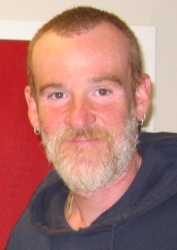 We
just finished driving through the Ninth Ward
in New Orleans. We’re getting to see
first hand the devastation of Katrina and Rita.
Seven months later, the only news that the
rest of the country gets is that the New Orleans
Saints will get to play in their stadium next
year. The rest of the country thinks, “Okay,
New Orleans must be doing okay?”
We
just finished driving through the Ninth Ward
in New Orleans. We’re getting to see
first hand the devastation of Katrina and Rita.
Seven months later, the only news that the
rest of the country gets is that the New Orleans
Saints will get to play in their stadium next
year. The rest of the country thinks, “Okay,
New Orleans must be doing okay?”
Things are not okay.
I will not insult the people here by trying
to explain what I have witnessed here and in
Houma. But I will share a few stories with
you.
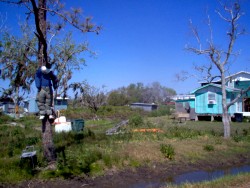 We
pulled into Isle de Jean Charles and a scarecrow
was hanging from a broken tree. Across its
face was written HELP US! Kid
and I were talking to an old shrimp boat captain.
He was telling us how the Federal Government
was trying to get their land for oil, and how
they also want to open it up for sports fishing.
When they all refused to sell, the Government’s
We
pulled into Isle de Jean Charles and a scarecrow
was hanging from a broken tree. Across its
face was written HELP US! Kid
and I were talking to an old shrimp boat captain.
He was telling us how the Federal Government
was trying to get their land for oil, and how
they also want to open it up for sports fishing.
When they all refused to sell, the Government’s 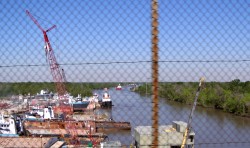 solution
to this was a law that says if there is more
than (I think) three feet of standing water,
the Federal Government can claim it as Federal
land, so when they built the new levy, they’re
going to build it NORTH of the island.
When we left, I shook his hand and told him
to take care of himself and he said, “We
may be a little Island, but we got a lot of
love.”
solution
to this was a law that says if there is more
than (I think) three feet of standing water,
the Federal Government can claim it as Federal
land, so when they built the new levy, they’re
going to build it NORTH of the island.
When we left, I shook his hand and told him
to take care of himself and he said, “We
may be a little Island, but we got a lot of
love.”
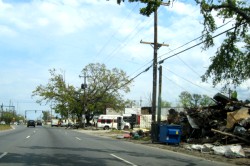 I
stopped to talk to a surveyor in the Ninth
Ward, and I just asked him if he thought the
Ninth Ward could ever recover, and he asked
me, “Are you healthy?” I
looked at him with a smile, and he said, “All
the rest of this is just stuff.” He
was happy that his kids were able to go back
to school.
I
stopped to talk to a surveyor in the Ninth
Ward, and I just asked him if he thought the
Ninth Ward could ever recover, and he asked
me, “Are you healthy?” I
looked at him with a smile, and he said, “All
the rest of this is just stuff.” He
was happy that his kids were able to go back
to school.
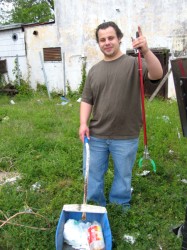 We
made one more stop before heading across Lake
Pontchartrain. We spoke to a young man named
Mohammed Abraham. He was picking up garbage.
While I was on the phone, Roger was speaking
to him, telling him about the Walk and the
Run. A few minutes later Mohammed came
back with two bottles of water and two bottles
of Gatorade for us. By this time I was
off the phone. We started talking to him about
how, if it wasn’t for the cars on the
roads, it would look like a ghost town. He
said it was pretty scary around there at night,
and that only 3 percent of
We
made one more stop before heading across Lake
Pontchartrain. We spoke to a young man named
Mohammed Abraham. He was picking up garbage.
While I was on the phone, Roger was speaking
to him, telling him about the Walk and the
Run. A few minutes later Mohammed came
back with two bottles of water and two bottles
of Gatorade for us. By this time I was
off the phone. We started talking to him about
how, if it wasn’t for the cars on the
roads, it would look like a ghost town. He
said it was pretty scary around there at night,
and that only 3 percent of 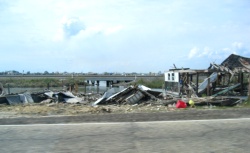 the
population had come back to the area.
the
population had come back to the area.
In Slidell, Louisiana, I heard stories of
a thirty foot wave that came through off the
Lake. Only a few houses were still standing. I
could go on, but I’ll leave you all with
this. Through all the pain and suffering,
everything that the people have had to endure,
everyone I spoke to left me with two things:
a thank you and a smile.
by Jim Toren, Road Manager,
Sacred Run 2006
Here
are some other pics from New Orleans and
Slidell, Louisiana...
And
here is an archive page - our schedule
in LaFourche Parish...
Top
Day
47 - Wednesday, March 29, 2006
Poplarville, Mississippi to Bay Springs, Mississippi
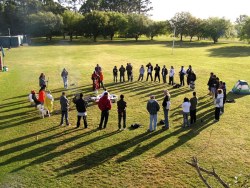 During
our Closing Circle last night, we talked about
our walk and run through Southern Louisiana,
about how hard it is to absorb all the emotion
and energy attached to the devestation we witnessed
here. Many of us expressed a kind of shock,
even a weariness in our body. How to cope with
disaster up close?
During
our Closing Circle last night, we talked about
our walk and run through Southern Louisiana,
about how hard it is to absorb all the emotion
and energy attached to the devestation we witnessed
here. Many of us expressed a kind of shock,
even a weariness in our body. How to cope with
disaster up close?
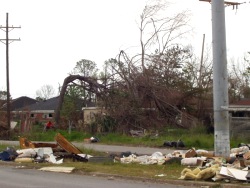 It
became apparent to us that this is a part of
sharing someone's pain. As we walked through
mile after mile of smashed homes, broken forests,
and places where no one lives or shops or eats
or goes to school anymore - we sensed in a
visceral way the loss and bewilderment that
comes of a natural catastrophe like Katrina/Rita.
And the SCALE of it was also a shock.
Not one person's disaster, nor that of a family
or a village, but of a whole urban and suburban
population.
It
became apparent to us that this is a part of
sharing someone's pain. As we walked through
mile after mile of smashed homes, broken forests,
and places where no one lives or shops or eats
or goes to school anymore - we sensed in a
visceral way the loss and bewilderment that
comes of a natural catastrophe like Katrina/Rita.
And the SCALE of it was also a shock.
Not one person's disaster, nor that of a family
or a village, but of a whole urban and suburban
population.
It makes you sick at first.
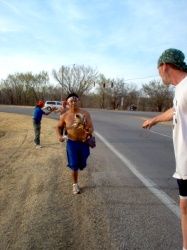 But
then you find yourself sharing not only the
pain of those who survived Katrina and the
floods. You talk to a neighbor who is picking
up trash; you lend a hand to a small-time landlord
who is cleaning out a rental in hopes of a
new tenant; you pitch in to rebuild a roof
or you make small talk with a clerk at a gas
station - and you find yourself sharing hope.
Because that's what people do. When you're
down, you pick yourself up. When it seems that
the government doesn't care, you raise your
voice and you call for justice. And meanwhile,
you pick up the trash and you reopen the school
and rebuild a safe place to call home. That's
what we do, we.
But
then you find yourself sharing not only the
pain of those who survived Katrina and the
floods. You talk to a neighbor who is picking
up trash; you lend a hand to a small-time landlord
who is cleaning out a rental in hopes of a
new tenant; you pitch in to rebuild a roof
or you make small talk with a clerk at a gas
station - and you find yourself sharing hope.
Because that's what people do. When you're
down, you pick yourself up. When it seems that
the government doesn't care, you raise your
voice and you call for justice. And meanwhile,
you pick up the trash and you reopen the school
and rebuild a safe place to call home. That's
what we do, we.
Our lives - I'm talking about
Sacred Runners and Walkers now - our lives
have been changed. Our sense of family has
widened to embrace the Houma Nation, and all
the country and city folks, and we know their
pain just a bit, and we take hope from their
hope. Energized, we pledge to remember them,
to tell their story in Washington, D.C. and
back home, and to take action for their well-being.
We rebuild now, together.
Here are two more reflections
from Sacred Walkers Tony Baugh and Tuffy Isham:
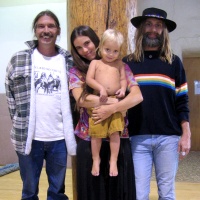 The
Houma Nation shows us something very, very
important; that even in the face of tragedy
and destruction, you cannot destroy the human
spirit. In fact, it will only make the people
stronger. We will survive. We are one.
The
Houma Nation shows us something very, very
important; that even in the face of tragedy
and destruction, you cannot destroy the human
spirit. In fact, it will only make the people
stronger. We will survive. We are one.
Tony Baugh
Big Island, Hawaii
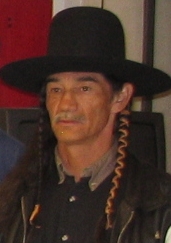 Me-Gwitch
to the Houma Nation for the love you have
shared with us. A special Me-Gwitch to Chief
Brenda D. Robichaux and her husband Dr. Mike
Robichaux and Felicity. Also special Me-Gwitch
to Clan Mother Mourning Dove. - Dove, you
are soooo beautiful. I loved doing the Gator
Waltz with you and that fry bread.... almost
as yummy as gumbo. Man, thank God for gumbo
and fry bread!
Me-Gwitch
to the Houma Nation for the love you have
shared with us. A special Me-Gwitch to Chief
Brenda D. Robichaux and her husband Dr. Mike
Robichaux and Felicity. Also special Me-Gwitch
to Clan Mother Mourning Dove. - Dove, you
are soooo beautiful. I loved doing the Gator
Waltz with you and that fry bread.... almost
as yummy as gumbo. Man, thank God for gumbo
and fry bread!
Tuff Isham
from Leech Lake, Minnesota, AIM Peace Warrior
Top
Day
50 - Saturday, April 1, 2006
Philadelphia, Mississippi
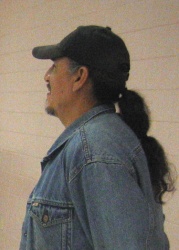 On
Thursday, we arrived on the lands of the Mississippi
Choctaw Nation outside of Philadelphia,
Mississippi. We are enjoying huge meals, gracious
accommodations, a fine Powwow,
and a sweat at the home of our host and Mississippi
Sacred Run coordinator, Ron Alex. Even with
the rain, maybe partly because of the rain,
this place is a paradise of green Mother-Earth
peacefulness and abundance.
On
Thursday, we arrived on the lands of the Mississippi
Choctaw Nation outside of Philadelphia,
Mississippi. We are enjoying huge meals, gracious
accommodations, a fine Powwow,
and a sweat at the home of our host and Mississippi
Sacred Run coordinator, Ron Alex. Even with
the rain, maybe partly because of the rain,
this place is a paradise of green Mother-Earth
peacefulness and abundance.
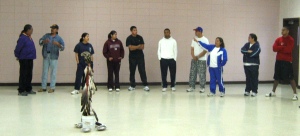 The
Sacred Run message is that All Life is
Sacred. So everywhere we go, we carry
an intense concern for the struggles of ALL
people to be free of prejudice and oppression.
Here in Neshoba County many of us honored yesterday's
California state holiday for Cesar Chavez,
and we are taking note of the significant civil
rights history here at our doorstep in Philadelphia,
Mississippi. This is the place where voting
rights activists Michael
The
Sacred Run message is that All Life is
Sacred. So everywhere we go, we carry
an intense concern for the struggles of ALL
people to be free of prejudice and oppression.
Here in Neshoba County many of us honored yesterday's
California state holiday for Cesar Chavez,
and we are taking note of the significant civil
rights history here at our doorstep in Philadelphia,
Mississippi. This is the place where voting
rights activists Michael 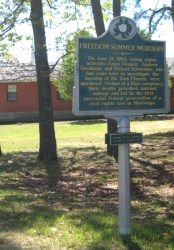 Schwerner,
Andrew Goodman and James Earl Chaney, were
killed on June 21, 1964, sparking a national
outrage among people of all races. The events
here in Philadelphia contributed to the growing
demand for civil rights for African Americans
in the U.S. and led to the first successful
federal prosecution of a civil rights case
in Mississippi.
Schwerner,
Andrew Goodman and James Earl Chaney, were
killed on June 21, 1964, sparking a national
outrage among people of all races. The events
here in Philadelphia contributed to the growing
demand for civil rights for African Americans
in the U.S. and led to the first successful
federal prosecution of a civil rights case
in Mississippi.
On the Philadelphia
website, the only reference to Schwerner,
Goodman and Chaney is on the county's Parks
page. There's a little memorial out east
of town on Route 16. I'm sure there are good
reasons for residents and leaders here to
forget or ignore that which makes this a
historic place in my mind. But a stop in
Philadelphia is a pilgrimage for anyone with
passion about the Civil Rights Movement in
the U.S. The grizzly story of the Ku
Klux Klan's triple murder is memorably portrayed
in the 1988 film, Mississippi
Burning. And more recently,
in 2005, there was national remembrance when
an 80-year-old Klansman, Edgar Ray Killen,
was brought to trial again with new evidence.
This time, Killen was convicted and sentenced.
From Indianz.com:
KKK leader on trial for slayings in Choctaw territory
Friday, June 10, 2005
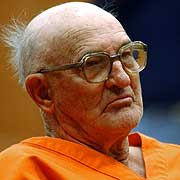 Jury
selection will begin on Monday for the retrial
of Edgar Ray Killen, a former Ku Klux Klan
member accused of killing three civil rights
workers in Philadelphia, Mississippi. Jury
selection will begin on Monday for the retrial
of Edgar Ray Killen, a former Ku Klux Klan
member accused of killing three civil rights
workers in Philadelphia, Mississippi.
 Philadelphia
is home to the Mississippi Band of Choctaw
Indians. Tribal members were denied seats
on the jury when Killen first went to
trial for the murders in 1864. An all-white
jury deadlocked on the original charges.
The case has attracted international
attention. It was the subject of the
1988 film Mississippi Burning. A number
of media outlets are coming to the city
to cover the trial. Philadelphia
is home to the Mississippi Band of Choctaw
Indians. Tribal members were denied seats
on the jury when Killen first went to
trial for the murders in 1864. An all-white
jury deadlocked on the original charges.
The case has attracted international
attention. It was the subject of the
1988 film Mississippi Burning. A number
of media outlets are coming to the city
to cover the trial.
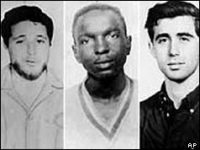 "There
are those who dread this being reopened," Don
Kilgore, 55, the Choctaw attorney general,
told USA Today. "And there are those
of us who see it as an exorcism."
William Spell, another lawyer for the
tribe, said he welcomes the attention. "Philadelphia
today is a model of racial harmony," he
told The Independent of UK. "There
are those who dread this being reopened," Don
Kilgore, 55, the Choctaw attorney general,
told USA Today. "And there are those
of us who see it as an exorcism."
William Spell, another lawyer for the
tribe, said he welcomes the attention. "Philadelphia
today is a model of racial harmony," he
told The Independent of UK. |
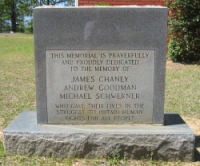 See
also: The
Philadelphia Coalition, Roots of Struggle,
Rewards of Sacrifice.
See
also: The
Philadelphia Coalition, Roots of Struggle,
Rewards of Sacrifice.
And for another interesting commentary,
see JohnSuggs.com/mississippi_burning/,
especially the entries for June 16 and September
18.
The memorial to Michael Schwerner,
Andrew Goodman and James Earl Chaney, is located
at Mt. Zion Church, off Hwy. 16 East in Neshoba
County.
Day
51 - Sunday, April 2, 2006
Choctaw Nation, Philadelphia, Mississippi
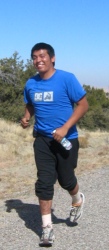 Our arrival and rest stop in Philadelphia has been exciting! We crossed the 3,000 mile mark accompanied by local Choctaw runners as we made our way into Choctaw lands. And many of us joined in solidarity with a brave local runner named Lou for the final two miles, taking it slowly with her, as she has had health problems in the past. The bond of friendship was sealed in this way - the Choctaw are here for us, and we are here for them.
Our arrival and rest stop in Philadelphia has been exciting! We crossed the 3,000 mile mark accompanied by local Choctaw runners as we made our way into Choctaw lands. And many of us joined in solidarity with a brave local runner named Lou for the final two miles, taking it slowly with her, as she has had health problems in the past. The bond of friendship was sealed in this way - the Choctaw are here for us, and we are here for them.
Half of us made camp at the tribal Hospitality House, and the other half at our host Ron Alex' home. We enjoyed a fine sweat on our arrival night (Thursday), and a good meal followed.
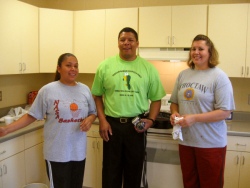 Friday began with an incredible breakfast of pancakes, sausage, bacon, and eggs at the Choctaw Fire Station. There was a downpour around noon, just before lunch was to be served outside the Justice Hall. Everyone pitched in when the event was moved
Friday began with an incredible breakfast of pancakes, sausage, bacon, and eggs at the Choctaw Fire Station. There was a downpour around noon, just before lunch was to be served outside the Justice Hall. Everyone pitched in when the event was moved 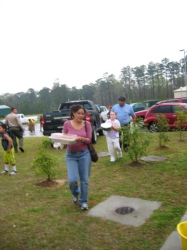 indoors, and a long line of "worker bees" took down the chairs and tables, and carried hot dishes, plates, napkins and everything to the gym. There, the various departments of the Choctaw police honored their members with an awards ceremony, and included Sacred Run in their "company picnic." Once again, the food was extraordinary - a potluck of astounding variety and proportion!
indoors, and a long line of "worker bees" took down the chairs and tables, and carried hot dishes, plates, napkins and everything to the gym. There, the various departments of the Choctaw police honored their members with an awards ceremony, and included Sacred Run in their "company picnic." Once again, the food was extraordinary - a potluck of astounding variety and proportion!
 Later on Friday, we attended the Pow-Wow at the Neshoba County Coliseum north of Philadelphia. Powerful drumming accompanied elegant and beautiful traditional dancers until late into the night. There were booths with traditional jewelry and clothing, food, artwork, and lots of other items. Many of us bought keepsakes and received and gave gifts. Sacred Run was honored with a special dance, and we were all introduced to the folks by an exceptionally well-dressed co-Master of Ceremonies, Dennis Banks.
Later on Friday, we attended the Pow-Wow at the Neshoba County Coliseum north of Philadelphia. Powerful drumming accompanied elegant and beautiful traditional dancers until late into the night. There were booths with traditional jewelry and clothing, food, artwork, and lots of other items. Many of us bought keepsakes and received and gave gifts. Sacred Run was honored with a special dance, and we were all introduced to the folks by an exceptionally well-dressed co-Master of Ceremonies, Dennis Banks.
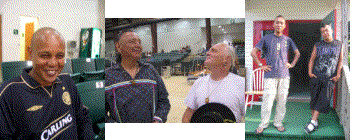 On Saturday, April 1st, some of our Sacred Runners played April Fools jokes on themselves - it was a hair cutting day! First it was Nuno who shaved his head, perhaps going for the Buddhist nun look. Later on, Feather surprised us all by giving himself a Mohawk! Gari followed suit with a Last-of-the-Mohicans look-alike Japanese-style Mohawk. And not to be totally outdone, Larry and Les shaved the sides of their heads for a fancy look of their own.
On Saturday, April 1st, some of our Sacred Runners played April Fools jokes on themselves - it was a hair cutting day! First it was Nuno who shaved his head, perhaps going for the Buddhist nun look. Later on, Feather surprised us all by giving himself a Mohawk! Gari followed suit with a Last-of-the-Mohicans look-alike Japanese-style Mohawk. And not to be totally outdone, Larry and Les shaved the sides of their heads for a fancy look of their own.
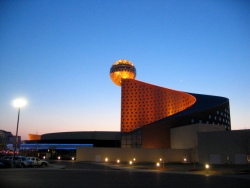 Saturday morning, Sacred Runners took many of the prizes in a morning benefit run for diabetes. Afterwards, we were treated to an incredible brunch at the Golden Moon Casino at Pearl River Resorts on the Choctaw Reservation. Later, at the Pow-Wow, we were treated to an early supper
Saturday morning, Sacred Runners took many of the prizes in a morning benefit run for diabetes. Afterwards, we were treated to an incredible brunch at the Golden Moon Casino at Pearl River Resorts on the Choctaw Reservation. Later, at the Pow-Wow, we were treated to an early supper 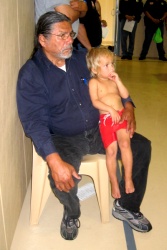 prepared by the Boy's Club. Another fine night of dancing and ceremonial celebrations followed.
prepared by the Boy's Club. Another fine night of dancing and ceremonial celebrations followed.
The Choctaw lands are are beautiful
and complex, and I think they are a great example
of the way people can band together to provide
services and build a strong community together.
Along with the pristine woods and streams,
we are witness to magnificent roads and buildings,
a complete "country-style city" with
every necessary infrastructure and an economic
engine that provides for all. This is a great
place to visit, and a wonderful community to
live in!
